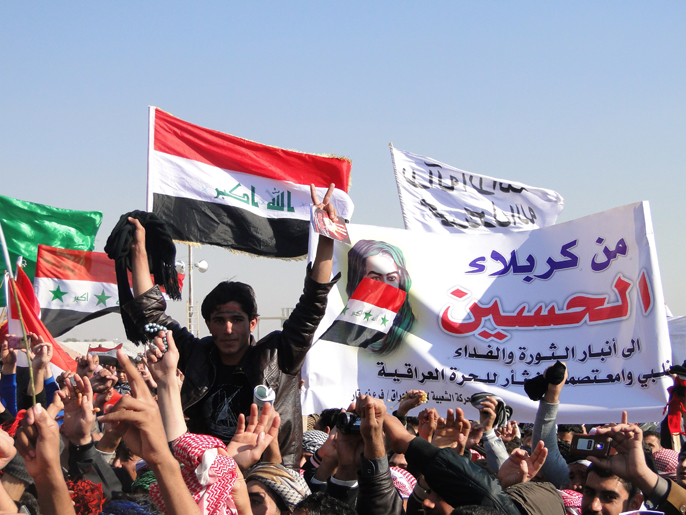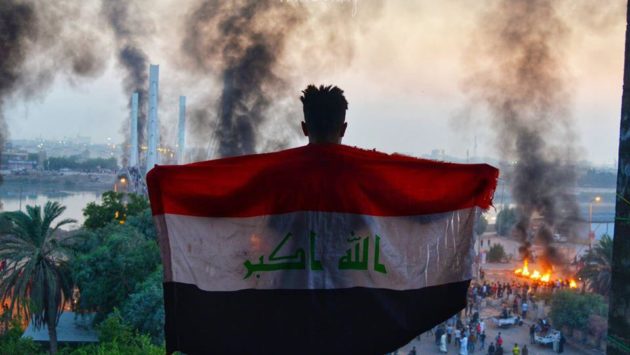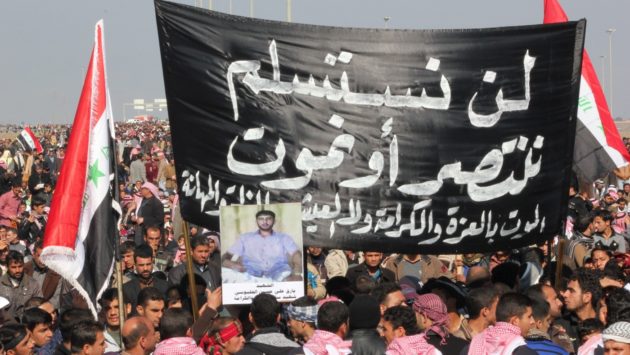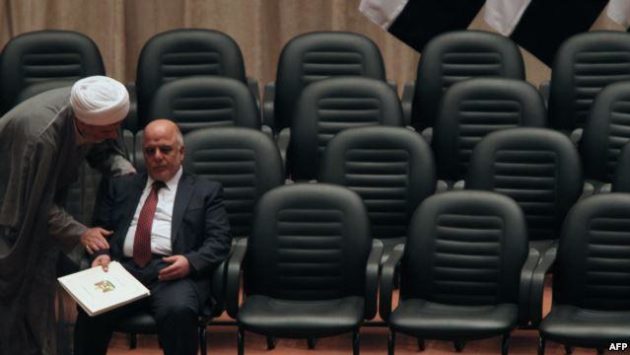Tipping Towards Iraq’s Squares: An Interview with Falah Alwan
An Interview with Falah Alwan ,
written by Ali Issa- Jan 22 2013, published by Jadaliyya
The Iraqi state releasing 335 detainees this past week? Prime Minster Nouri al-Maliki bussing in a few hundred paid “supporters” to rally? What gives? Signs point to the wave of mass anti-government protests mostly centered around the provinces al-Anbar, Niniweh, and Salah al-Deen, shaking Iraq since 21 December 2012. These evolving mobilizations have sometimes brought out numbers approaching hundreds of thousands (as in Mosul’s Ahrar Square) and led to the blocking of a major Iraq-Jordan-Syria Highway. Some have also claimed the recent mobilizations as an “Iraqi Spring.” By 7 January 2013, Iraqi security and pro-government thugs began physical attacks against protesters. The demands—ever a contentious issue given the many layers of influence in Iraq—have focused on releasing Iraq’s detained—namely women— the casual use of the death penalty, and the closely related issue of “combating sectarianism,” which lies at the heart of Iraq’s many social and political crises. In a complex interplay, much of civil society and the (sectarian) political elite have struggled over the meaning of these protests. Even interpreting the word “equality” very differently—especially as these calls have come from areas of Iraq traditionally associated with Sunni populations. Though garnering more media than the mass protests of say early-to-mid-2011, according to blogger Reider Visser, “International media are attracted to these protests precisely because they fit in a sectarian narrative about a simplistic Sunni-Shi’a battle over Iraq.” How “sectarian” are these protests exactly, and what might be their potential beyond that narrow frame? To get a firmer understanding of the moment’s dynamics, Ali Issa talked to Baghdad-based Falah Alwan, President of the Federation of Workers Councils and Unions in Iraq (FWCUI), about what brought this about and where it all may be going. The interview was originally conducted in Arabic. Ali Issa (AI): What happened recently in Iraq to trigger mass mobilizations seeing as how the street has been very quiet the past several months? Falah Alwan (FA): The protests that many Iraqi cities are witnessing now are not actually in reaction to a passing event. That is to say they are not the direct result of some government action. The street that your question describes as “quiet” is actually silent only as a result of repression, especially after the protests of February 2011 when the authorities revealed their violence openly—using the army to clamp down on nonviolent protests and firing live ammunition at peaceful protestors. It may be that a particular event triggered what is happening now, but the content of the protests now goes well beyond the Prime Minister vs. the Finance Minister. You have [surely] noticed the development of the slogans people are raising. So while the “event” was the arrest of the finance minister’s security guards, the protestors demanded the end of “Article 4: Terrorism”, which is a law that authorities have used as an instrument to repress any dissent. They have also used it against all strikes and nonviolent sit-ins that workers demanding their rights have organized for years—especially the protests of the Basra oil workers in 2006-2007. Protesters are also now demanding the end of sectarianism or sectarian discrimination, while others ask for work opportunities and a remedy to unemployment. AI: What is the situation of prisoners in Iraq now, especially women prisoners? Are there reliable numbers? FA: With regards to women prisoners we [at FWCUI] used to receive field reports from a team at the Organization of Women’s Freedom in Iraq that visited women’s prisons, and they would report numbers of rape cases and other violations. The consolidation of government control post-2009, and especially in the aftermath the 2011 protests, have made these visits extremely difficult. Also, political, civil society, and feminist groups are absolutely banned from visiting the prisons that hold people for political reasons, under accusations of “terrorism.” As for numbers, according to government institutions, there are one thousand women detained, with four thousand arrested and under interrogation. Other media, however, put the numbers at the tens of thousands. AI: If elite political and sectarian forces inside and around the regime have played a role in the recent protests, how has the street gone beyond those designs? In your opinion what is the biggest challenge to the movement spreading to the rest of Iraq? FA: It is possible for any individual to project their judgments and understandings on any phenomenon, but this does not change the core of the issue. In addition, a situation may remain “quiet” for decades but continue to hold within it the elements of an explosion that can be triggered by any event. Looking at the objective basis, it is these elements that shifted the scenario. Tunisia remained under Ben Ali’s repressive regime for decades without us seeing the “elements” of a revolution. The suicide of Mohamed Bouazizi sparked events that led to the revolution that overtook all of Tunisia, then Egypt, then the Middle East and even beyond. Not looking at Iraq as a chain of events, but rather seeking the roots, they lie in a political system and the division of a society based on what they call Shi’a, Sunni, Kurdish, Turkmen, and Christian “component parts.” The government then says that it does not discriminate between one part or another, and that “Iraq is one.” Then politicians wrestle over dividing the ministries between political blocs based on ethnicity, each in a team that hates the other, uniting only in their animosity towards Iraqi society. The centralization of power in Shi’a Islamic parties, the spread of corruption in the government institutions were set up, and the inability of the authorities to create a broad political frame that can contain the whole society has all lead to a general societal disgust, which the people have expressed through a series of protests and sit-ins across Iraq, that preceded the moment we are living now. All this led to discrimination against large sections of Iraq in the form of policies and actions like arrests, accusing any opposition group of having affiliation with al-Qaeda or the Ba’ath, etc. These then are the bases that today’s movement launched from. On one hand, this movement is expressing in a direct and practical way that the sectarian regime cannot lead society under any circumstance. On the other, the areas or provinces that were accused [by the authorities] of sectarianism or [links with] al-Qaeda and the like are now raising slogans that directly threaten the sectarian structure. This is because the regime actually relies on sectarian claims so it may then reproduce itself by “counteracting” a sectarian or Saddamist banner. These regions have broadcast their opposition to sectarianism and put forward broad slogans—some of which are democratic and civil. As this grows it will seriously strike the ethnic discourse of the central government—which I believe will begin to identify itself on another basis in order to sustain its efforts. The Maliki government victory over the people in February 2011, and then settling scores with its political opponents resulted in a narrow, top-down regime that only became more and more insular. The present wave may put an end to this tyranny if social forces can develop through it. AI: How do the protesting forces attempt to go beyond sectarianism? FA: From the first days, slogans were demanding unity and a rejection of sectarianism and division. Coming about instinctually and organically—calling for brotherhood between Shi’a and Sunni, Arabs and Kurds . . . [but that is] as if “unity” were a coming together of Shi’a and Sunni. “Unity” is a positive slogan, no doubt, but raising it in this way, I believe, will again reproduce sectarian political tendencies. I feel that putting out a societal understanding of “unity” based on an objective class analysis is a serious political goal that falls on the shoulders of political groups that have a clear understanding of Iraqi society. AI: What is the relationship between these protests and the labor movement or the political formations that emerged after 25 February 2011—what some call Iraq’s forgotten uprising? FA: I already talked about the relationship to 25 February. Now labor, across Iraq—while acknowledging the lack of deep-rooted institutions—has tools of struggle at its disposal. We are talking about a social class that is at the center of events, even if they are not participating clearly and directly as the working class, since the political situation and sectarian divisions deeply paralyze the organizing abilities of workers. In the end the strengthening of any mass democratic movement will improve the climate for direct workers’ struggle. AI: In your opinion, what could truly make this a turning point in Iraqi political life? FA: This moment could be a crossroads for more than one possibility—all is open now. First, it is possible that these protests could transform into a broad social revolution that changes the political system and builds another. And a new socio-political model could develop, one that opposes the model imposed on, and advertised for, in the region. The development of the present movement could refresh the revolution in the region as a whole and will not be apart from it—especially if it spreads through progressive forces to the Southern and Kurdish regions. Another possibility is the continuing stubbornness of the government, its success in strengthening sectarianism, and the eventual deterioration to armed struggle and widespread unrest. This may be similar to what took place in Syria as well as in Iraq during 2006 and 2007, now with the lack of a US presence. The regressive forces that risk losing their seats—should this movement grow—could push society in that direction. They could even attempt to divide the whole of Iraq officially. The third possibility is that the protests remain concentrated in the West and North while the regime’s forces remain elsewhere. Then there might be a truce between some of the forces involved in the protests and the authorities, with a gradual shrinking of the movement. All of these are possible. Though what has been realized now is that the regime is facing a broad mass of people that publicly reject its policies and boldly raise banners stating so. In other words, the people have intervened in a sphere that the authorities want to monopolize. Jadaliyya :http://www.jadaliyya.com/pages/index/9699/tipping-towards-iraqs-squares_an-interview-with-fa


 [Iraqis in the Northern province of Salah al Deen on 11 January 2013 holding a banner that reads “No to Sectarianism…exclusion, marginalization and the politicization of the judiciary.” Image from the “Great Iraqi Revolution” Facebook page.]
[Iraqis in the Northern province of Salah al Deen on 11 January 2013 holding a banner that reads “No to Sectarianism…exclusion, marginalization and the politicization of the judiciary.” Image from the “Great Iraqi Revolution” Facebook page.]

